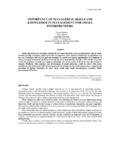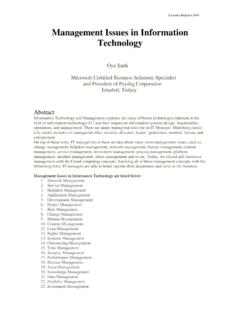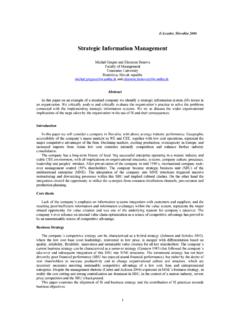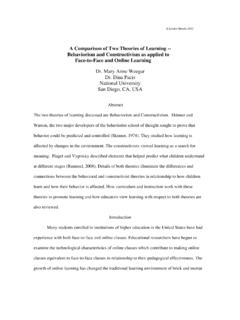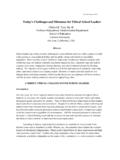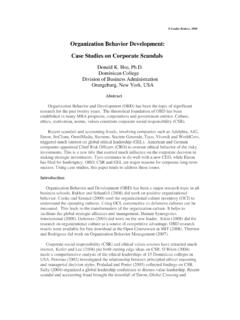Transcription of Leadership Lessons from the Animal Kingdom - CASA
1 E-Leader Singapore 2010 1 Leadership Lessons from the Animal Kingdom Prof. Dr. Patrick Kim Cheng Low and Sik-Liong Ang, MBA University Brunei Darussalam Gadong, Brunei Abstract: Here, using various examples and a number of Chinese proverbs, the authors indicate, draw parallels as well as highlight and examine the Leadership Lessons drawn from nature, particularly so, of the Animal Kingdom .
2 Interestingly, the Chinese visor or perspective is added to these interpretations. Key words: Leadership , eagle, tiger, horse, crane, tortoise, snake, monkey, frog, resilience, leading change. Introduction Leadership matters. And there is a great need for better leaders (Beam, 2004). Certainly if one wants to be successful, one should develop one s Leadership skills? Leadership skills are a skill set that can be possessed both in humans and in animals. Animals can be good examples of leaders for they lead their groups by influencing, showing examples, guiding and constantly communicating with their followers.
3 They have the aim and goal for their followers to follow. For example, animals that travel in groups, when making migratory or movement decisions, often depends on social interactions among their own group members. This is important since they need to have good communicating skills; they transfer information and/ or show action. This is done by signaling to one another or making noises which can only be understood by their own species. Information that is transferred is crucial as in many cases, very few of them have enough information, such as knowledge about the location of a food source, or of a migration route, and therefore in a group there is always a leader that knows all the E-Leader Singapore 2010 2information and thus guides its followers in the right direction.
4 This leader is the one that takes responsibility of the safety of its followers (caring them) and in turn, the followers are dependent on their leader. To the authors, Leadership involves using the head, the heart and the hands. The leader should make full use of his or her analytical skills and social or interpersonal skills. By using the hands , we take it to mean that the leader should lead by the example, actions that the leader not only speaks of but perform. The leader also needs to be hands-on.
5 The Paper s Purpose & Objectives As in Aesop s fables where Lessons are learnt from stories told, here, Leadership Lessons are learnt from the nature and habits of animals. The purpose and objectives of this paper is to indicate and draw parallels, and highlight the Leadership Lessons and its applications from nature with special reference to the Animal Kingdom , and where necessary, such an interpretation is seen from the Chinese perspective. The Eagle When there is no vision, the people perish.
6 (Proverbs 29, 18). With a superior mind, the leader can come up with a vision or a dream, and that vision should be communicated to the people. And how true, creating a vision for the people, the leader s dreams can help create a better world for the people. One Leadership lesson drawn from the eagle is that of vision. It is said that the eagle soars or flies high when it is hunting. From the way of the eagle, the leader can learn the need to have a high vantage point, giving vision to the people.
7 The leader should have a vision and see the big picture. And vision, having it is a necessity, serves as a guide or even as a beacon and a guiding light to the people. E-Leader Singapore 2010 3 From the eagles, one can also learn about resilient or tough Leadership . Leaders need to be tough and resort to positive thinking, changing the I can t to I can! and the I ll try to do to I ll do it! When eagles are 30 years old, they go through a process of renewal. Finding a hidden place high in the mountains, the old eagle with curved beak begins to claw at its face, and tear out the old feathers that by now become less airborne.
8 As a result, it bleeds badly. But this is vital for the eagle in order to renew its strength. If the eagle did not do this, it would not be able to live to its normal 40 years (Ozirney, 2009). It is thus vital for the eagle to undergo the change process to gain its strength and this builds the eagle s resilience. By the same token, mankind simply needs to accept the change process, learn and grow. It s part of life and living. It is apt at this point to quote a Chinese phrase: The eagle is soaring high, spreading its wings.
9 When a Chinese businessperson receives a calligraphic painting of an eagle from his or her business associates, it depicts that the well wishers wish the business person well, and in fact, they are sending him or her good intentions and wishes of business expansion. More specifically, in Chinese culture, the eagle symbolizes an individual s, hence can be the leader s strength, ambition and emulation since (s)he can fly as high as (s)he desires. In many Chinese brush paintings, the eagle can be depicted as catching a fish against the backdrop of a rising sun and mighty waves.
10 The turbulence of the vast ocean is never an obstacle for the strong and determined eagle. The depiction of an eagle can normally be taken as being optimistic. The rising sun, which foresees every possibility in life, is a symbol of opportunities and bright future, greatness and magnificence an individual can achieve with all efforts and aspiration (s)he devotes. Hence, the eagle can be a good source of inspiration and encouragement. The Tiger A leader needs to be a risk taker too.
